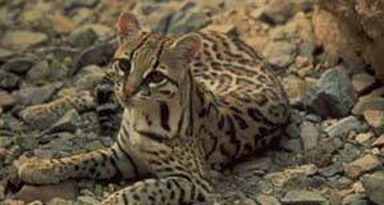
 The Conservation Fund and the U.S. Fish and Wildlife Service (Service) announced yesterday the protection of 7,428 acres of ranch land near Laguna Atascosa National Wildlife Refuge in Willacy County. The land, protected through a conservation easement granted by the Frank Yturria family, provides vital habitat for two endangered species, the ocelot and the aplomado falcon.
The Conservation Fund and the U.S. Fish and Wildlife Service (Service) announced yesterday the protection of 7,428 acres of ranch land near Laguna Atascosa National Wildlife Refuge in Willacy County. The land, protected through a conservation easement granted by the Frank Yturria family, provides vital habitat for two endangered species, the ocelot and the aplomado falcon.
"This is a great day for ocelots and for the aplomado falcon," said Benjamin Tuggle, the Service's Southwest Regional Director. "We strive to work cooperatively with private landowners, like the Yturria family, for the conservation of natural resources. By partnering with organizations like The Conservation Fund, we ensure the long term protection of habitat."
Situated on the border between the United States and Mexico, this region has been called the last great habitat. Hundreds of species of birds, mammals, reptiles and insects depend on this diverse assemblage of wetlands, coastal prairie, savannah, dense mesquite and thorn scrubbrush for survival. Loss of habitat has impacted a number of species, including the endangered ocelot and the aplomado falcon.
The ocelot is an elusive and solitary wild cat with markings similar to a leopard or jaguar. It once ranged from south Texas to Arkansas and Louisiana. Today approximately only 50 ocelots exist in the entire United States, including a breeding population found on Laguna Atascosa National Wildlife Refuge and additional cats found on the Frank Yturria Family Ranch. Ocelots are larger than a house cat but smaller than a bobcat. They are commonly recognized by their long, ringed tail that is about one third the length of their body, as well as their distinct spots and rounded ears.
Once widespread throughout the American Southwest, the aplomado falcon disappeared in South Texas in the 1940s and 1950s due to widespread loss of habitat. In 1996, Dr. Frank Yturria worked with the Peregrine Fund to reintroduce the aplomado falcon onto one of his properties. The long wings and white trailing edge easily distinguishes the aplomado falcon when it is in flight. Adults have a steel-gray dorsal plumage with a dark band separating colors on its underside. While the species remains endangered, this new conservation easement will greatly benefit the ocelot and the aplomado falcon as well as other species.
The Conservation Fund, the Service and the Friends of the Wildlife Corridor worked with neighboring ranchers Frank and Mary Yturria to purchase a conservation easement on a portion of the Yturria's property where the presence of eight ocelots has been documented. The easement allows the land to remain privately owned, but the Yturrias agree to keep the habitat intact, permanently. Frank has been working with the Service for more than 30 years to help protect endangered wildlife habitat, through conservation easements and the sale of his land.
Frank said: "In the 1950s my Father, who was a conservationist, sold 2,500 acres in Hidalgo County to the U. S. Fish and Wildlife Service for wildlife habitat preservation that became part of the wildlife corridor; and in 1986 my brother, sister and I sold 1,700 acres in Willacy County that includes a large historic salt lake known as 'La Sal Vieja.'"
Funding for the purchase of the easement came from the sale of other, less strategic Service lands, as well as from the federal Land and Water Conservation Fund, America's premier land conservation program.
In 1989, Frank Yturria donated 500 acres out of his San Francisco Ranch to the Service for ocelot habitat. In 1999, he and his brother and sister sold 12,600 acres in Cameron County to The Conservation Fund, which became part of the Laguna Atascosa National Wildlife Refuge. To this acreage was added an additional 9,000 acres, which made this the largest wetlands restoration project in the country to date. In 2007, Frank granted a 697 acre wildlife easement on his San Francisco Ranch for preservation of the endangered ocelot and enlarged this tract by 1,300 acres in 2009. Frank Yturria has been a leader in establishing conservation efforts in South Texas.
"This is a win-win-win - for wildlife, for the refuge and for the landowner," said Andy Jones, Texas director for The Conservation Fund. "Today we applaud the Frank Yturria family, whose roots in the Texas ranching community date back to 1860. Together, we celebrate a steadfast commitment to preserving the South Texas landscape for wildlife and for ranchers. As we look at the future for incredible species like the ocelot and aplomado falcon, public-private partnerships like these will become more important than ever."
Image U.S. Fish and Wildlife Service/Tom Smylie




































